The Stones of Halifax
Halifax is one of those cities that used to be great, back when the world was a different place. Back when navel might meant more than nightlife. Back when ships had sails and guns had bayonets, Halifax was one hopping town. Like Carthage, until the Romans burned it to the ground. Like Saint Louis, until… well, I’m not sure what happened to Saint Louis, and I realize it's inland, but still, walking around Saint Louis you can tell it used to be one heck of a town.
Halifax still has this weird beauty. Part of it is just good genes. Like high cheekbones, they never get old. Halifax has some natural assets that neither time nor the global economy can wear away. The ocean, for one. The deep harbour still comes in handy. As James Salter writes of Barcelona at dawn: “All the great avenues are pointing to the sea.”
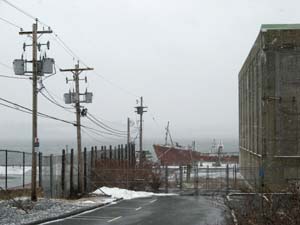
Fog has a way of making dilapidation seem intentional. As Ruskin writes of Venice in the final period of her decline: “a ghost upon the sands of the sea, so weak – so quiet, - so bereft of all but her loveliness, that we might well doubt, as we watched her faint reflection in the mirage of the lagoon, which was the City, and which the Shadow.” I had never noticed before how much this portion of NSCAD looks like a Venetian Palazzo.
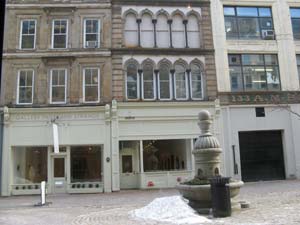
There are some very hip restaurants in Halifax now, even by Montreal standards. And there are funky clothing boutiques that I can’t afford to buy things in; is that a sign of progress? Condo developments crust the waterfront like barnacles, hastily thrown up and unsightly. Half the storefronts on Barrington Street stand empty, the same as ever. I was in Halifax the day the NFB building burned down. When was that, fifteen years ago? The façade still stands charred and buttressed with timber, the window-plywood heavily postered. Next door the Kyber Art Centre hangs on by a thread. Across the street from these ruins: a restaurant called Chives and a café called Ciboulette. As a Montrealer I find this perplexing. A friend and I meet for tea at Ciboulette. We haven’t seen each other in almost two years but the first thing I want to know is: does everyone know that ciboulette is the French word for chives? Yes, she assures me, Ciboulette and Chives are run by the same people. Phew. We are sitting in the second-floor window. A portion of the interior wall has been removed to reveal a stone volute, part of the building’s original façade. This is a surprise. From the outside the building is nondescript. I love that they’re preserved it, my friend says, but hate knowing it was bricked over in the first place.
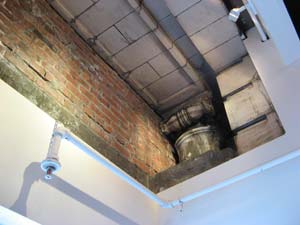
In The Stones of Venice Ruskin addresses himself to the task of determining some law of right, “which we may apply to the architecture of all the world and of all time.” He deduces that we require of buildings two practical duties: “acting and talking: - acting, as to defend us from weather or violence; talking, as the duty of monuments of tombs, to record facts and express feelings; or of churches, temples, public edifices, treated as books of history, to tell such history clearly and forcibly.” Certainly, in Halifax, defending us from weather is of utmost importance. The one free day I have to walk around it blows and spits snow fiercely. The virtues of Halifax’s predominantly short squat architecture are clear. The graveyard’s gravestones do seem forcibly expressive though. They say: Get inside you idiot, before you catch your death of cold.
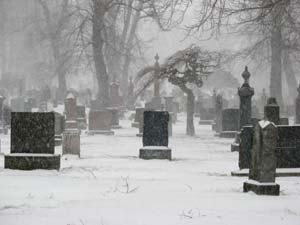
The most beautiful thing about Halifax is that in ten minutes you can be outside it. I don’t mean in the suburbs, I mean completely outside. If you survive the circular logic of the Armdale Rotary, that is. My last day in the city I meet friends for brunch at Jane’s on the Commons. Afterwards, I have about an hour to kill and they have a car. Let’s go somewhere rugged, I say. They say: Chebucto Head, it’s like Peggy’s Cove but a cliff. Perfect! An alarming number of brand new mega-mansions now cling like blue mussels to barren bluffs along the Herring Cove Road. I’d like to think that if I had enough money to buy up the last ocean front property on the continent I’d build something pretty on it, but who’s to say. These houses are mere shells, and, as Ruskin says of shells: “their being mere emptiness and deserted houses, must always prevent them, however beautiful in their lines, from being largely used in ornamentation.”
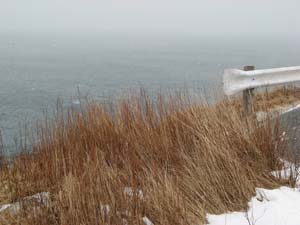
During World War II Halifax Harbour was the primary fast convoy departure and arrival point in eastern North America. There several battles between Allied surface escorts and Nazi U-boats the waters off Chebucto Head. Those were the days. A concrete hull of the Royal Canadian Navy coastal gun battery built to ward off the U-boat menace is all that remains. The wind is so strong that it’s a struggle to push the car door open. We stand aslant to the blowing snow at the edge of the lighthouse’s ruined parking lot and attempt to distinguish ocean from sky. A foghorn goes off directly behind us, so loud that I scream. I scream so loud that I stumble. When I stumble I discover I’m standing on a patch of black ice. So then I really stumble, and fall face first into my friend. I get my lip-gloss all over her scarf. Damn. Why do all of my Nova Scotia stories end in embarrassment? Fortunately my friend is not standing on black ice. We manage to right ourselves. We don’t fall off Chebucto Head and down into a salt-watery grave to spend eternity with the U-boats. So, a happy ending after all.
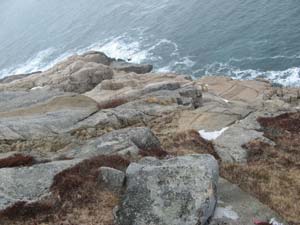
. . . . .
Halifax still has this weird beauty. Part of it is just good genes. Like high cheekbones, they never get old. Halifax has some natural assets that neither time nor the global economy can wear away. The ocean, for one. The deep harbour still comes in handy. As James Salter writes of Barcelona at dawn: “All the great avenues are pointing to the sea.”

Fog has a way of making dilapidation seem intentional. As Ruskin writes of Venice in the final period of her decline: “a ghost upon the sands of the sea, so weak – so quiet, - so bereft of all but her loveliness, that we might well doubt, as we watched her faint reflection in the mirage of the lagoon, which was the City, and which the Shadow.” I had never noticed before how much this portion of NSCAD looks like a Venetian Palazzo.

There are some very hip restaurants in Halifax now, even by Montreal standards. And there are funky clothing boutiques that I can’t afford to buy things in; is that a sign of progress? Condo developments crust the waterfront like barnacles, hastily thrown up and unsightly. Half the storefronts on Barrington Street stand empty, the same as ever. I was in Halifax the day the NFB building burned down. When was that, fifteen years ago? The façade still stands charred and buttressed with timber, the window-plywood heavily postered. Next door the Kyber Art Centre hangs on by a thread. Across the street from these ruins: a restaurant called Chives and a café called Ciboulette. As a Montrealer I find this perplexing. A friend and I meet for tea at Ciboulette. We haven’t seen each other in almost two years but the first thing I want to know is: does everyone know that ciboulette is the French word for chives? Yes, she assures me, Ciboulette and Chives are run by the same people. Phew. We are sitting in the second-floor window. A portion of the interior wall has been removed to reveal a stone volute, part of the building’s original façade. This is a surprise. From the outside the building is nondescript. I love that they’re preserved it, my friend says, but hate knowing it was bricked over in the first place.

In The Stones of Venice Ruskin addresses himself to the task of determining some law of right, “which we may apply to the architecture of all the world and of all time.” He deduces that we require of buildings two practical duties: “acting and talking: - acting, as to defend us from weather or violence; talking, as the duty of monuments of tombs, to record facts and express feelings; or of churches, temples, public edifices, treated as books of history, to tell such history clearly and forcibly.” Certainly, in Halifax, defending us from weather is of utmost importance. The one free day I have to walk around it blows and spits snow fiercely. The virtues of Halifax’s predominantly short squat architecture are clear. The graveyard’s gravestones do seem forcibly expressive though. They say: Get inside you idiot, before you catch your death of cold.

The most beautiful thing about Halifax is that in ten minutes you can be outside it. I don’t mean in the suburbs, I mean completely outside. If you survive the circular logic of the Armdale Rotary, that is. My last day in the city I meet friends for brunch at Jane’s on the Commons. Afterwards, I have about an hour to kill and they have a car. Let’s go somewhere rugged, I say. They say: Chebucto Head, it’s like Peggy’s Cove but a cliff. Perfect! An alarming number of brand new mega-mansions now cling like blue mussels to barren bluffs along the Herring Cove Road. I’d like to think that if I had enough money to buy up the last ocean front property on the continent I’d build something pretty on it, but who’s to say. These houses are mere shells, and, as Ruskin says of shells: “their being mere emptiness and deserted houses, must always prevent them, however beautiful in their lines, from being largely used in ornamentation.”

During World War II Halifax Harbour was the primary fast convoy departure and arrival point in eastern North America. There several battles between Allied surface escorts and Nazi U-boats the waters off Chebucto Head. Those were the days. A concrete hull of the Royal Canadian Navy coastal gun battery built to ward off the U-boat menace is all that remains. The wind is so strong that it’s a struggle to push the car door open. We stand aslant to the blowing snow at the edge of the lighthouse’s ruined parking lot and attempt to distinguish ocean from sky. A foghorn goes off directly behind us, so loud that I scream. I scream so loud that I stumble. When I stumble I discover I’m standing on a patch of black ice. So then I really stumble, and fall face first into my friend. I get my lip-gloss all over her scarf. Damn. Why do all of my Nova Scotia stories end in embarrassment? Fortunately my friend is not standing on black ice. We manage to right ourselves. We don’t fall off Chebucto Head and down into a salt-watery grave to spend eternity with the U-boats. So, a happy ending after all.

. . . . .


0 Comments:
Post a Comment
<< Home